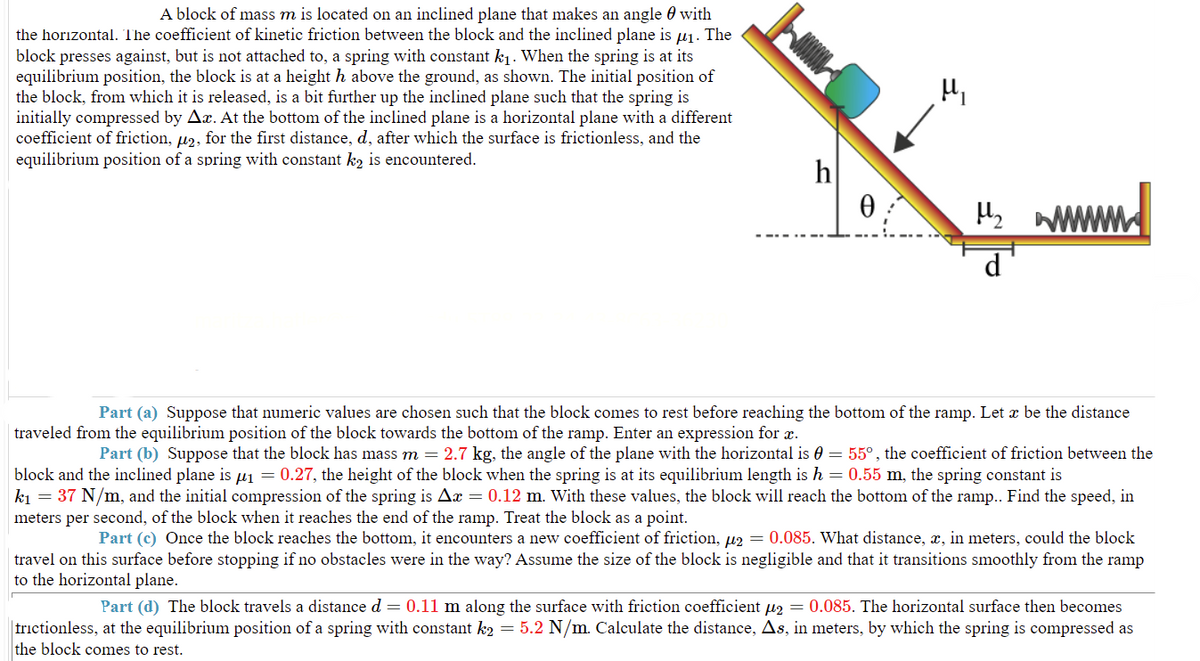A block of mass m is located on an inclined plane that makes an angle with the horizontal. The coefficient of kinetic friction between the block and the inclined plane is μ₁. The block presses against, but is not attached to, a spring with constant k₁. When the spring is at its equilibrium position, the block is at a height h above the ground, as shown. The initial position of the block, from which it is released, is a bit further up the inclined plane such that the spring is initially compressed by Ax. At the bottom of the inclined plane is a horizontal plane with a different coefficient of friction, µ2, for the first distance, d, after which the surface is frictionless, and the equilibrium position of a spring with constant ką is encountered.
A block of mass m is located on an inclined plane that makes an angle with the horizontal. The coefficient of kinetic friction between the block and the inclined plane is μ₁. The block presses against, but is not attached to, a spring with constant k₁. When the spring is at its equilibrium position, the block is at a height h above the ground, as shown. The initial position of the block, from which it is released, is a bit further up the inclined plane such that the spring is initially compressed by Ax. At the bottom of the inclined plane is a horizontal plane with a different coefficient of friction, µ2, for the first distance, d, after which the surface is frictionless, and the equilibrium position of a spring with constant ką is encountered.
Related questions
Question

Transcribed Image Text:A block of mass m is located on an inclined plane that makes an angle with
the horizontal. The coefficient of kinetic friction between the block and the inclined plane is μ₁. The
block presses against, but is not attached to, a spring with constant k₁. When the spring is at its
equilibrium position, the block is at a height h above the ground, as shown. The initial position of
the block, from which it is released, is a bit further up the inclined plane such that the spring is
initially compressed by Ax. At the bottom of the inclined plane is a horizontal plane with a different
coefficient of friction, μ2, for the first distance, d, after which the surface is frictionless, and the
equilibrium position of a spring with constant k₂ is encountered.
Part (a) Suppose that numeric values are
such that block comes to rest before reaching the
the ramp. Let x
distance
traveled from the equilibrium position of the block towards the bottom of the ramp. Enter an expression for x.
Part (b) Suppose that the block has mass m = 2.7 kg, the angle of the plane with the horizontal is = 55°, the coefficient of friction between the
block and the inclined plane is µ₁ = 0.27, the height of the block when the spring is at its equilibrium length is h = 0.55 m, the spring constant is
k₁ = 37 N/m, and the initial compression of the spring is Ax = 0.12 m. With these values, the block will reach the bottom of the ramp.. Find the speed, in
meters per second, of the block when it reaches the end of the ramp. Treat the block as a point.
Part (c) Once the block reaches the bottom, it encounters a new coefficient of friction, µ2 = 0.085. What distance, æ, in meters, could the block
travel on this surface before stopping if no obstacles were in the way? Assume the size of the block is negligible and that it transitions smoothly from the ramp
to the horizontal plane.
Part (d) The block travels a distance d = 0.11 m along the surface with friction coefficient 2 = 0.085. The horizontal surface then becomes
trictionless, at the equilibrium position of a spring with constant k₂ = 5.2 N/m. Calculate the distance, As, in meters, by which the spring is compressed as
the block comes to rest.
h
0
μ₁
₂www
d
Expert Solution
This question has been solved!
Explore an expertly crafted, step-by-step solution for a thorough understanding of key concepts.
This is a popular solution!
Trending now
This is a popular solution!
Step by step
Solved in 4 steps with 4 images
